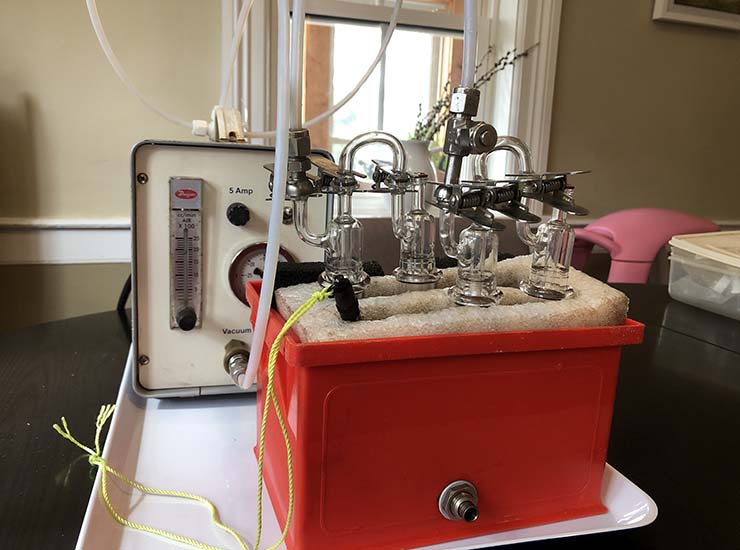Bats in buildings: How airborne eDNA can help you identify bat species at risk
June 16, 2023
June 16, 2023
Historical or abandoned buildings can be a bat magnet. Environmental DNA is a way to identify a bat species before you try to move it.
Flap, click, squeak. And repeat. After a few days of hearing sounds above your head in your old office building the thought hits you: we’ve got bats. So, you just call a pest control company and let them do their thing, right? Well, it’s not that simple.
Depending on where you’re located, you’ll likely need to identify what species of bat is living in your building before considering removal. Bat detection is important, because many countries, states, and provinces have legislation regarding bats classified as species at risk. If you forcibly remove an at-risk family of bats from your building, you could be liable for hefty fines from local and federal government agencies. Your building could be considered protected habitat.
But if you're looking at solutions, conventional methods of studying bats are a challenge and can be labor intensive and costly.

In Ontario, little brown bats—aka little brown myotis—are threatened by a disease called white nose syndrome, and they’re facing extinction. They’re considered an at-risk species and shouldn’t be removed from a building without a permit from the proper government agency.
As a senior ecologist, I’ve spent years working in bat detection. I’ve recently conducted research that suggests a novel approach to identifying these nocturnal flying mammals: airborne environmental DNA (eDNA).
Environmental DNA is naturally shed by organisms into their environment, such as streams, rivers, oceans, soils, even in fecal matter. So, instead of sampling for an animal itself, you can sample the environment or habitat—without having to capture, handle, or even see the animal you’re trying to identify.
This air sampling technique can determine the presence of bats in buildings. If you’re worried about potential at-risk bats flying around in your historical buildings, read on to learn more about bat detection and my research with eDNA.
Before I dive into my research, let’s discuss some background. With the endangered status of several bat species in North America, studying bats in buildings has become a regulatory challenge. To determine if a building is protected under species-at-risk legislation, you need a survey to see if there are at-risk bats. I’m particularly thinking of governments, urban development corporations, mining corporations, and energy and utility corporations that may have bats present.
In Ontario, where I’m based, some bats became listed as endangered species in 2013 and protected under the province’s Endangered Species Act. For example, little brown bats—aka little brown myotis—are threatened by a disease called white nose syndrome, and they’re facing possible extinction. If you’re looking to perform maintenance on an older building in Ontario—or demolish an abandoned building—and you suspect you might have bats like the little brown bats, it’s important to know if they’re present. If you try to remove at-risk bats without taking the proper steps, a government agency could serve you with a C$1 million fine for a first-time offense. So, it’s clearly not worth skipping this step.

Andrew Taylor conducted his research into airborne eDNA with a captive colony of big brown bats.
Before you reach out to a pest control company, talk to a consultant for bat detection. Once your consultant finishes their survey, you can get a permit from the responsible provincial or federal agency. If it turns out that you have at-risk bats present, your permit will have conditions on how a pest control company can remove that habitat—likely only during certain times of the year, which lessens the impact on the animals.
Let’s briefly discuss the standard ways of approaching bat detection before we talk about using airborne eDNA. I’ve found that conventional surveys are labor intensive and can have some pitfalls.
In Ontario and many other places, standard surveys involve using high ultrasonic microphones that capture bats’ high-frequency calls. Since different bats have slightly different frequencies and calls, you can look at your recorded bat calls on a spectrogram and try to determine species based on that information.
This technique can be challenging, especially with larger, multistory buildings. Why? It can be very labor-intensive to position enough people with microphones to observe all parts of a building at once. And since some bats have very similar calls, it can be hard to tell with confidence what species are present. When you’re using DNA, there’s no question.
Outside of Ontario, consultants in other jurisdictions may perform trapping surveys or try to net the species as they’re flying out. Both of those techniques can also be very labor intensive.
Conventional methods of studying bats are a challenge and can be labor intensive and costly.
During the past few years, I’ve teamed up with research partners at Genidaqs and McMaster University to use eDNA to assess the presence of bats in buildings, using different air-sampling techniques in an indoor environment. Stantec’s Greenlight research fund has supported our work. For this research, we conducted sampling with a captive colony of big brown bats, which is a common bat species in North America but isn’t considered a species at risk where I’m based. We tried three sampling techniques to capture eDNA:
Our experimental design involved sampling different volumes of air and varying numbers of bats in rooms or containers of different volumes. This allowed us to assess the parameters needed to achieve reliable bat detection.
We detected eDNA with all three sampling techniques—which is great. But for the first two methods, we couldn’t consistently detect the species, which isn’t practical because you need to have confidence in your surveys.
The third technique consisted of passive sampling, where we put traps—consisting of tray with glass bead, as well as glass tiles—on the floor to collect particulate matter that settled from the air. We then swabbed the surface to collect eDNA. Thankfully, this passive sampling returned higher concentrations of eDNA and was the most reliable detection method in indoor environments.

One eDNA sampling technique involved pumping air through this liquid impinger.
I’m excited that we found a successful method. DNA can provide consultants and their clients with confident results, since they’ll be looking at a section of genetic code that is unique to a species of bat.
Using airborne eDNA is a novel approach for bat detection, and I’m grateful that my research partners and I had the opportunity to explore it. The next step? Regulators in different jurisdictions, who currently accept results from more conventional approaches of bat detection, should learn more about the effectiveness of eDNA. We’ll be sharing these results at conferences and with regulators.
If you’re concerned about bats flapping above your head in your heritage office building, I hope you’re learned about the importance of bat detection. It’s exciting to think how eDNA sampling for bats could be the survey technique of the future.